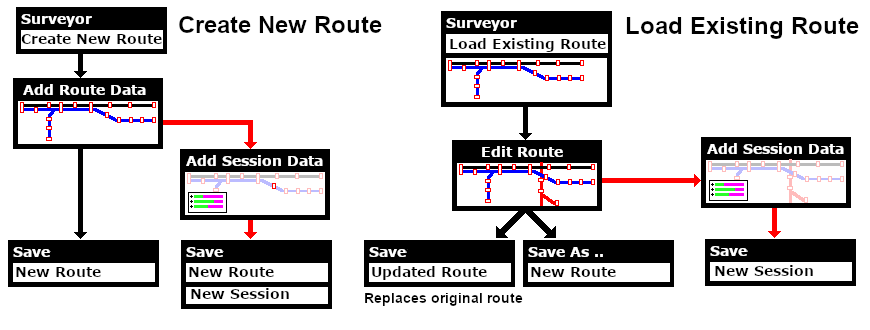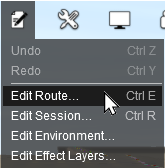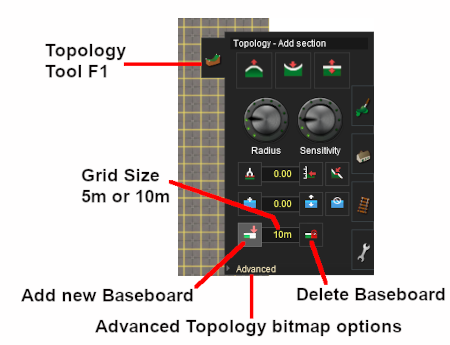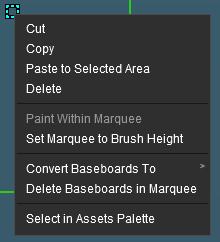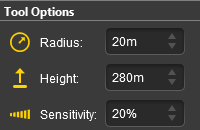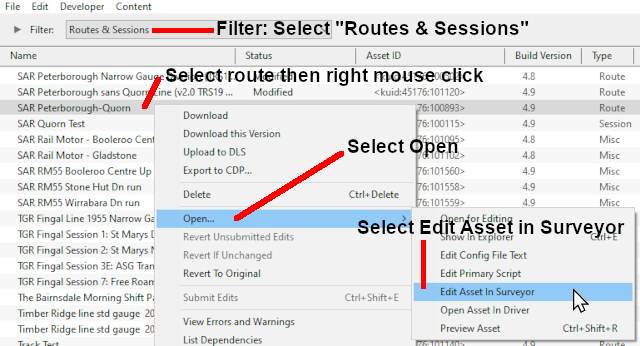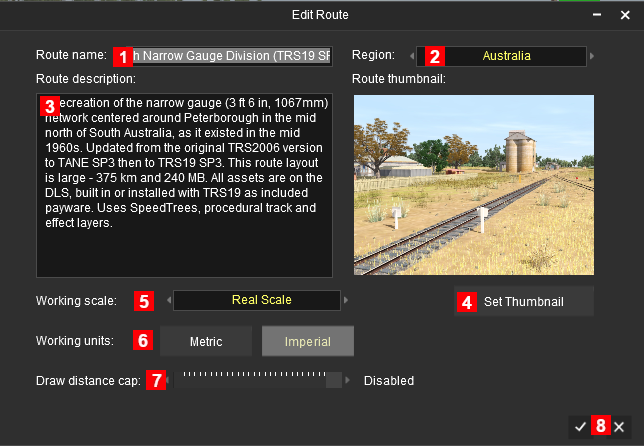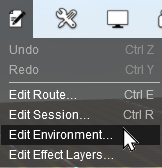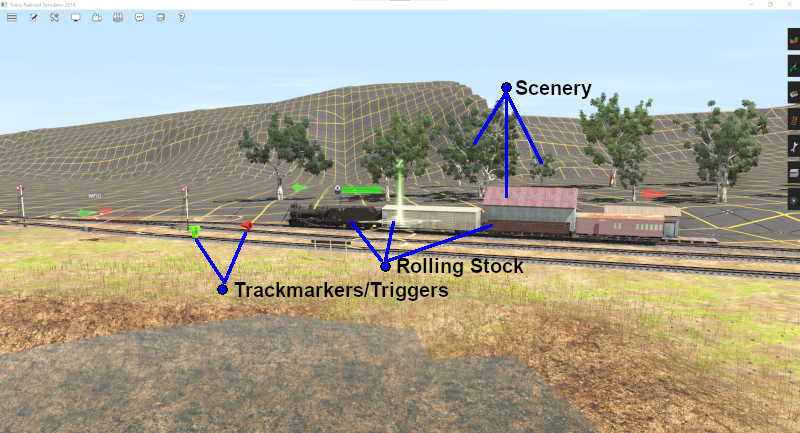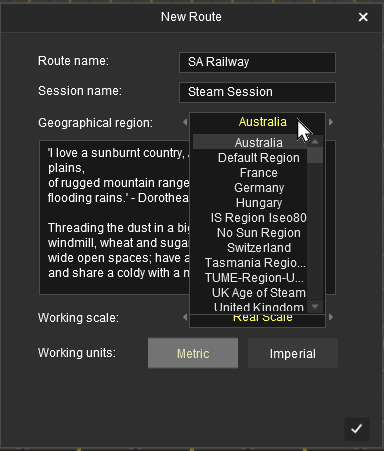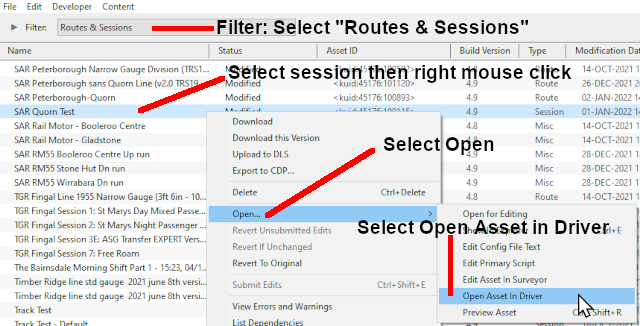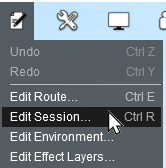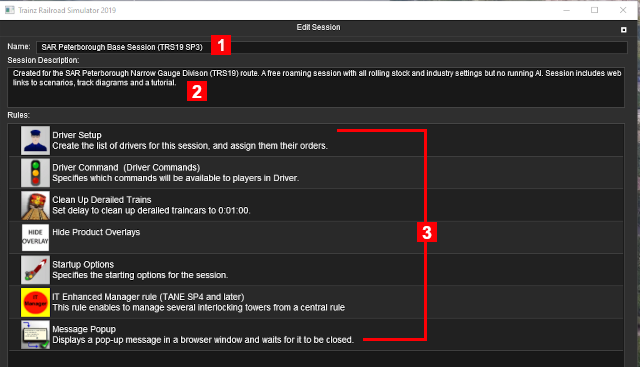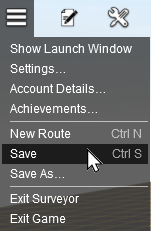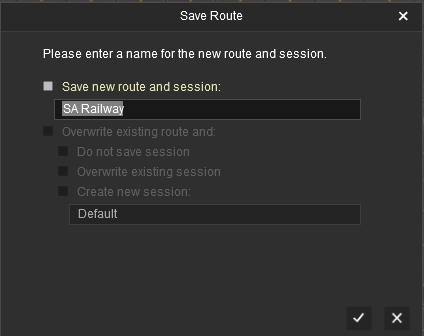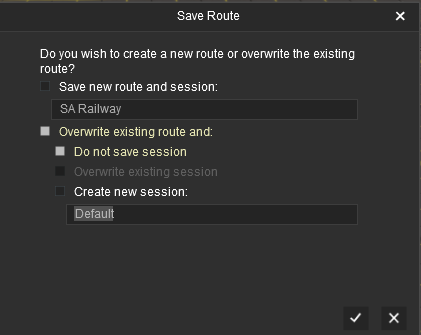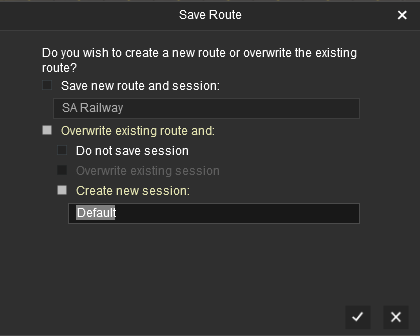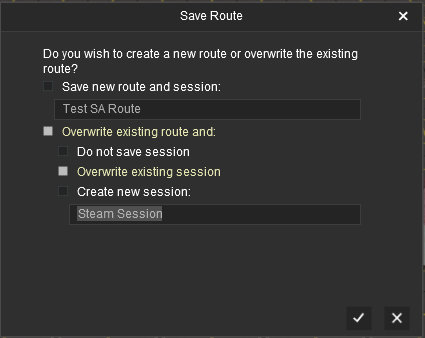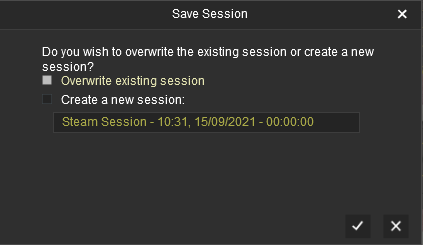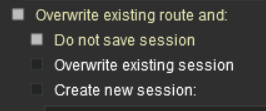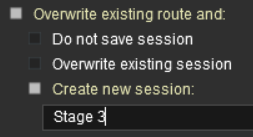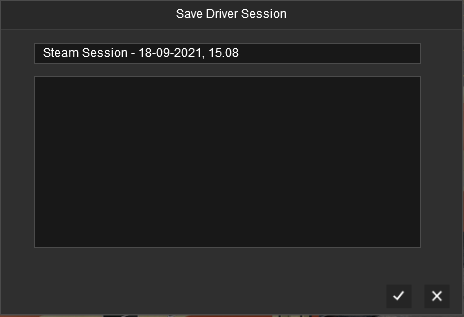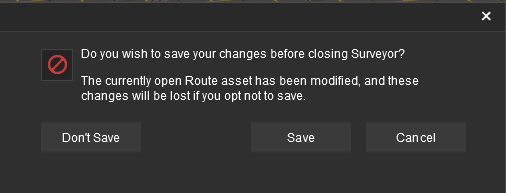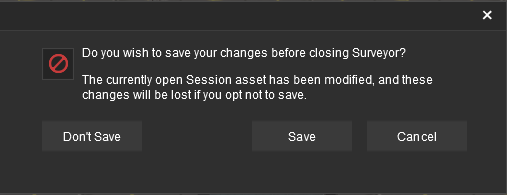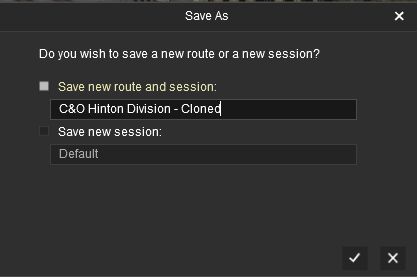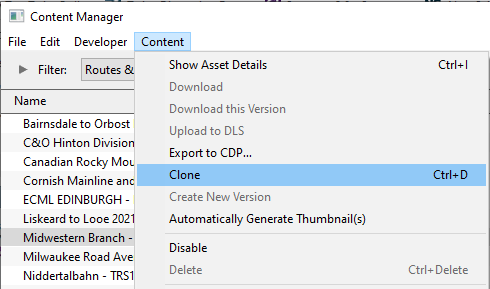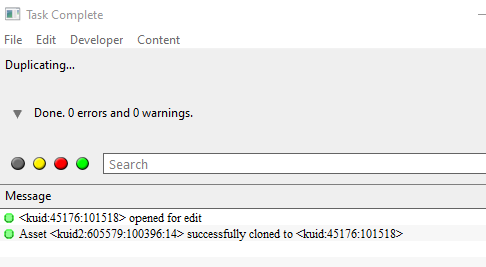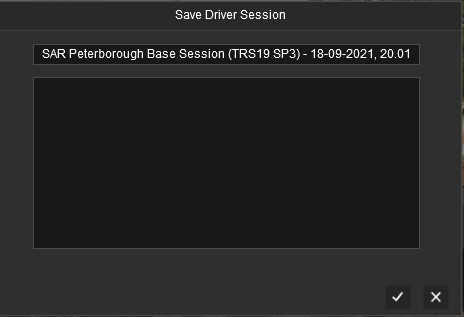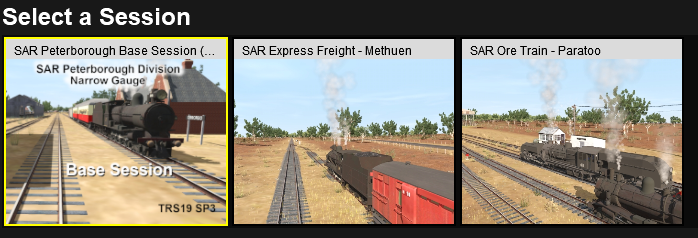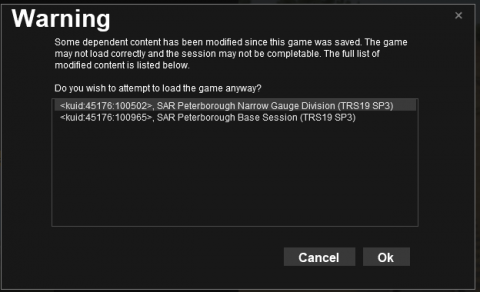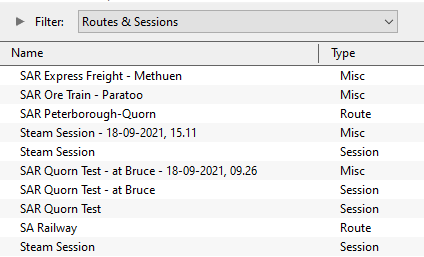Route and Session Basics
m (→Creating a New Route) |
m |
||
| Line 257: | Line 257: | ||
<tr valign="top"> | <tr valign="top"> | ||
<td>[[image:DotPoint1.JPG|link=]]</td> | <td>[[image:DotPoint1.JPG|link=]]</td> | ||
| − | <td>You do not have to add | + | <td>You do not have to add a <span style="color: white; background-color: black; font-weight: 700; font-size: 15px;"> Session name </span> but when you save a new route without a named session a default session will be automatically saved with the name '''Default'''. This can later cause confusion if a multitude of different '''Default Sessions''' appear so it is '''recommended''' that a unique '''Session name''' be entered at this point.</td> |
</tr> | </tr> | ||
<tr valign="top"> | <tr valign="top"> | ||
| Line 265: | Line 265: | ||
<tr valign="top"> | <tr valign="top"> | ||
<td>[[image:DotPoint2.JPG|link=]]</td> | <td>[[image:DotPoint2.JPG|link=]]</td> | ||
| − | <td>Setting a | + | <td>Setting a <span style="color: white; background-color: black; font-weight: 700; font-size: 15px;"> Geographical region </span> sets some basic features of the route - such as its latitude (used to determine the season of the year), the altitude (in metres) of the first baseboard, the number and types of moving road vehicles (if any) and the side of the road they drive on, to name a few. If none of the installed regions are suitable you can download others from the '''DLS''' or create a region of your own - see '''[[image:WikiLink.PNG|link=]] [[How to Create a Region Asset|How to Create a Region Asset]]'''</td> |
</tr> | </tr> | ||
<tr valign="top"> | <tr valign="top"> | ||
<td>[[image:DotPoint3.JPG|link=]]</td> | <td>[[image:DotPoint3.JPG|link=]]</td> | ||
| − | <td>The | + | <td>The <span style="color: white; background-color: black; font-weight: 700; font-size: 15px;"> Working scale </span> provides measurements that are comparable to model railroading dimensions, but the actual (physical) sizes of the layout and its assets are not altered or scaled down. It is only the '''Surveyor Ruler''' tool that will be affected. The choices are between '''Real scale''' (which is the default), '''G scale''' (100m real scale = 4.4m G scale), '''HO scale''' (100m real scale = 1.1m HO scale) and many other options.</td> |
</tr> | </tr> | ||
<tr valign="top"> | <tr valign="top"> | ||
<td>[[image:DotPoint4.JPG|link=]]</td> | <td>[[image:DotPoint4.JPG|link=]]</td> | ||
| − | <td>The | + | <td>The <span style="color: white; background-color: black; font-weight: 700; font-size: 15px;"> Working units </span> provides a choice between '''Metric''' (metres, kilometres) and '''Imperial''' (yards, miles) which only affects measurements used by rulers and track distances, and for train speeds ('''km/h''' or '''mph''').<br> |
Note that '''track speed signs''' are always locked at either metric (km/h) or imperial (mph) - there are separate speed signs available for each. The signs will not be altered by this selection but their values will be converted. So a track speed sign that is set at 40 mph, for example, will still be displayed as '''40''' but it will be read as 64.3 km/h in '''Driver''' if the '''Working Units''' have been set to '''metric'''. So it will be less confusing if you use the speed signs that are in the same working units as your route.<br> | Note that '''track speed signs''' are always locked at either metric (km/h) or imperial (mph) - there are separate speed signs available for each. The signs will not be altered by this selection but their values will be converted. So a track speed sign that is set at 40 mph, for example, will still be displayed as '''40''' but it will be read as 64.3 km/h in '''Driver''' if the '''Working Units''' have been set to '''metric'''. So it will be less confusing if you use the speed signs that are in the same working units as your route.<br> | ||
Altitudes are always measured and displayed using '''metric''' units (metres).</td> | Altitudes are always measured and displayed using '''metric''' units (metres).</td> | ||
| Line 284: | Line 284: | ||
</table> | </table> | ||
<br> | <br> | ||
| − | When you click the | + | When you click the [[image:Tick.PNG|link=|alt=Tick]] icon at the bottom right of the '''New Route''' window the route will be created with a single flat '''baseboard'''. Clicking the <span style="font-weight: 700; font-size: 15px; color: white; background-color: black;"> x </span> on the top right will close the window and cancel the data entry.<br> |
| + | |||
| + | Depending on the settings you have entered and the version of Trainz you are using, you will see the following (shown below right but without the added yellow and white labels and descriptive objects).<br> | ||
<table width=1000> | <table width=1000> | ||
<tr valign="top"> | <tr valign="top"> | ||
| Line 375: | Line 377: | ||
<table> | <table> | ||
<tr valign="top"> | <tr valign="top"> | ||
| − | <td colspan= | + | <td colspan=2>The Marquee area, shown with a green border in the image below right, shows the positions where 3 new baseboards will be created to add to the existing baseboard. The Marquee area has a '''Context Tool''' icon as shown in the image.</td> |
</tr> | </tr> | ||
<tr valign="top"> | <tr valign="top"> | ||
<td>'''3.''' </td> | <td>'''3.''' </td> | ||
<td>'''Left''' click on the '''Context Tool''' icon or press the <span style="font-weight: 700; font-size: 15px; color: white; background-color: black;"> T </span> key to open up the '''Marquee Context Menu'''.<br> | <td>'''Left''' click on the '''Context Tool''' icon or press the <span style="font-weight: 700; font-size: 15px; color: white; background-color: black;"> T </span> key to open up the '''Marquee Context Menu'''.<br> | ||
| − | [[image:S20_MarqueeContextTool.png|link=]]</td> | + | <table> |
| + | <tr valign="top"> | ||
| + | <td>[[image:S20_MarqueeContextTool.png|link=]]</td> | ||
<td>[[image:S20_MarqueeDrawnArea.png|link=|alt=Marquee drawn area]]</td> | <td>[[image:S20_MarqueeDrawnArea.png|link=|alt=Marquee drawn area]]</td> | ||
| + | </tr> | ||
| + | </table> | ||
| + | </td> | ||
</tr> | </tr> | ||
</table> | </table> | ||
Revision as of 08:54, 31 December 2022
The information in this Wiki Page applies to TRS19, Trainz Plus and TRS22. This page is intended to provide you with an overview of the properties and features of Routes and Sessions when creating layouts for Trainz. More detailed descriptions of these various features plus instructions on getting you started with creating Routes and Sessions can be found in the Trainz Wiki How To Guides - links are provided at the end of this document.
|
Workflow Diagrams
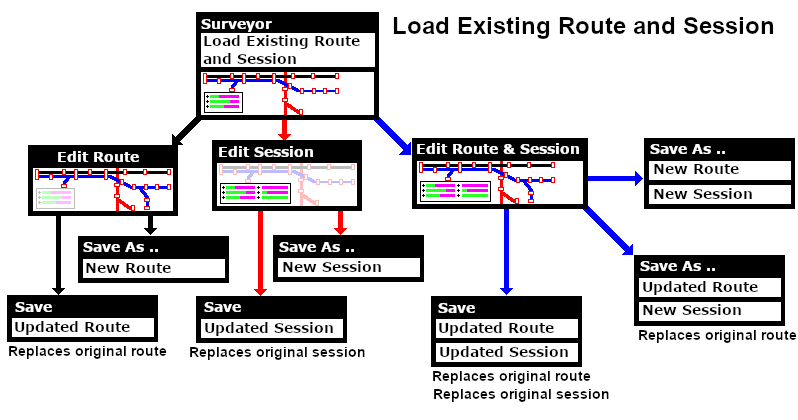 |
Trainz Worlds
The virtual worlds that Trainz creates can be classified as:-
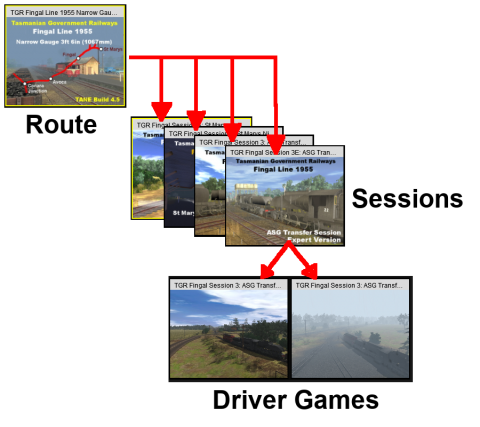 |
Routes are created in Surveyor and contain most (if not all) of what you will see in your virtual Trainz world. You can have many different routes, limited only by your storage space. Routes can be built to represent different geographical regions (real or imagined) and different periods of time (past, present, future). Routes also control the environment settings in your virtual world, such as your geographic location and altitude, the season of the year, lighting conditions and the weather. Routes can have:-
Sessions are also created in Surveyor but are designed to be run in Driver. Sessions contain the instructions that will control your trains when they are operating in automatic or "AI" mode in your route. They also control the goods your trains will carry, load and unload at industries along the way, regardless of whether you are driving them manually or using the AI. You can create different sessions for different aspects of your railway - freight, passenger, shunting or a mixture - or for different seasons of the year or times of the day. Sessions are where you can program the behaviour of objects in your virtual Trainz world. A session can also contain scenery items that are specific to a particular railway operation, season of the year or time of day that will only appear in that specific session. Sessions also control the environment settings in your virtual world, such as lighting conditions and the weather. Sessions can have:-
|
What is a Route?
A route (also known as a "Layout") consists of most of what you will see on the screen when using Surveyor and Driver. Things such as the landform or terrain, most (if not all) of the scenery items, the ground textures, the effect layers (TurfFX and Clutter), plus some "environmental" features.
A route consists of two parts:-
- Route Data and
- Route Layers.
| When you save a Route, all the items in the Route Data and Route Layers will be saved |
Route Data:
| The Route Data stores all those features that are painted into a layout using a brush tool | |
| The Route Data stores all the Environmental Data including the World Origin (latitude, longitude, altitude) |
This covers all those visual elements that are "painted" in Surveyor with a brush tool and all the Environmental features.
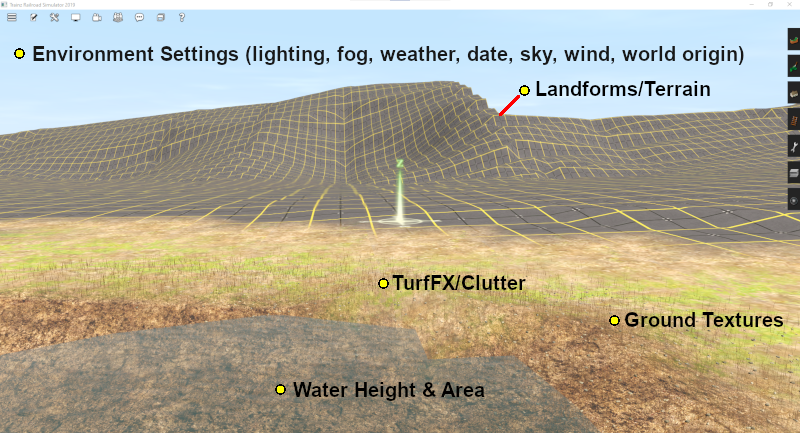
Route Data consists of:-
- Landforms (Terrain) - baseboards and ground height
- Water height and spread
- Ground Textures including the grid pattern which is a texture
- TurfFX, Clutter and Water - found in the Effects Layers
- Environmental Settings - World Origin (latitude, longitude, altitude), Water Surface (rough/calm/etc), Snow Altitude, Lighting (sun, ambient and water colours), Sky (clouds), Road Traffic (on/off), Date (day, month), Wind strength, Fog level, Weather (rain/fine/snow), Brightness level. You must edit and save the route for these settings to become part of the Route Data - see the Trainz Wiki page
How to Use the Environment Tools for more details.
Route Layers:
| Route Layers are used to hold the scenery assets that you want to appear in all sessions created for the route |
All scenery assets are held in layers. Route Layers give you a way of organising or grouping the assets displayed in your route.
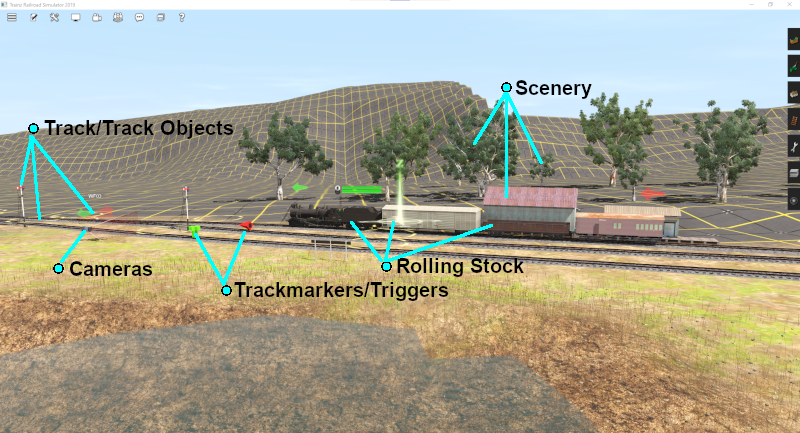
Route Layers have those scenery items that you want to always appear.
Route Layers can contain:-
- Track and Track Objects (such as signals, switches, bridges, tunnels, speed signs, etc)
- Most (or all) scenery items (e.g. buildings, trees, rocks, active industries/stations) and scenery splines (e.g. roads, fences, etc)
- Rolling Stock (including locos) - Note: It is strongly recommended that all rolling stock be placed into a Session Layer
- Lineside and Fixed Cameras
- Trackmarks, Triggers, Direction and Priority Marks
|
 |
A detailed description of Layers can be found on the Trainz Wiki Page How to Use Layers |
Loading (and Creating) a Route
The Main Menu screen is shown below. The first option (shown highlighted in the image) opens Driver/Surveyor with all its options including loading and creating a route.
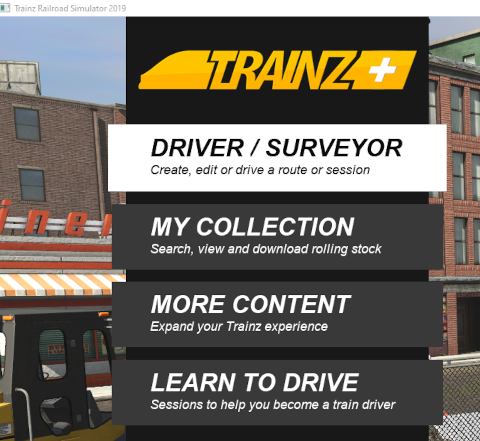
In Driver/Surveyor a strip of thumbnails for all the installed Routes will be shown at the base of the screen. The strip will scroll horizontally if there are too many to display. Just move the mouse pointer onto any thumbnail to reveal the scroll bar device.

The MAIN MENU button will take you back to the starting or main screen.
The Sort By A-Z button (top right of the image above) will give you a drop down menu of sorting options for the thumbnail list.
The ![]() button (top right of the image above) will expand the thumbnail list to fill the screen - click it again to return the thumbnails to the strip at the bottom of the screen.
button (top right of the image above) will expand the thumbnail list to fill the screen - click it again to return the thumbnails to the strip at the bottom of the screen.
The thumbnail images are colour coded.
| Payware on DLC | Must be purchased and downloaded, but some may be free - depending on your membership options. If you click a thumbnail with this colour a DOWNLOAD button will appear on the bottom right of the screen. If a price is included in the button then that is the purchase price (in $US) | |
| Payware installed | Already installed from the DLC. DLC items cannot be deleted. To remove them use the Uninstall option in the Content Store from the Launcher. You can reinstall them later without any additional cost | |
| Installed | Downloaded from the Download Station (DLS) or created by you. This includes any cloned DLC Routes and Sessions (see |
|
| |
Multiplayer | For simultaneous development by multiple players. Special conditions apply |
Creating a New Route
On the Driver/Surveyor screen the route options are shown as a set of buttons at the bottom of the screen.
![]()
Click CREATE ROUTE . This will start Trainz Surveyor and open the New Route Dialogue Window.
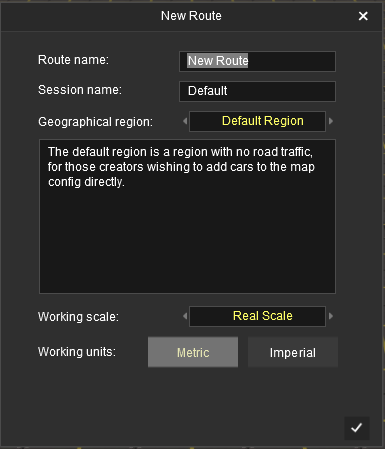 |
|
It is strongly advised that you enter some details before clicking the tick icon to create the new route. This will save you time and hassle later.
| Route name: | Enter a name for your new Route (keep it simple) |
| Session name: | Enter a name for your Session (again keep it simple) - see Notes: below |
| Geographical region: | Select a region from the drop down list |
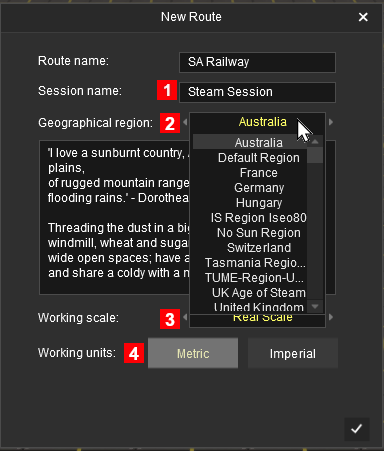 |
|
When you click the icon at the bottom right of the New Route window the route will be created with a single flat baseboard. Clicking the x on the top right will close the window and cancel the data entry.
Depending on the settings you have entered and the version of Trainz you are using, you will see the following (shown below right but without the added yellow and white labels and descriptive objects).
In Surveyor ClassicIn Surveyor Classic (also known as S10), which is supplied with TRS19 and TRS22 and is an option in Trainz Plus, the baseboards are controlled using the Topology Tools. To open the tools fly-out either click the Topology Tool Tab or press the F1 key. |
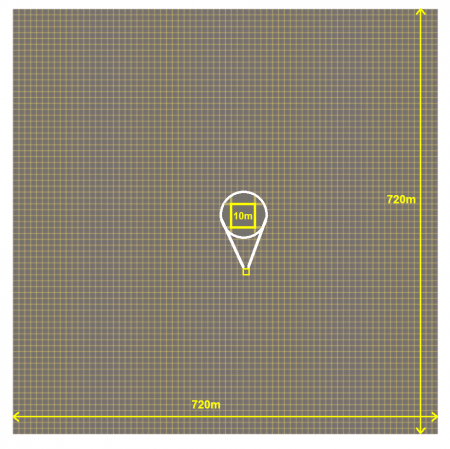 |
| The Key Topology Tools, as shown in the diagram above, are:- | |
| Add New Baseboard - click (it will stay active until another button is clicked) and then click in a blank area outside the baseboard to add a new baseboard in that position. Each click will add a new baseboard at the same altitude as the first | |
| Delete Baseboard - click (it will stay active until another button is clicked) and then click anywhere on a baseboard to delete that baseboard. You will get a warning dialogue window - you CANNOT undo this operation to restore a deleted baseboard | |
Grid Size - a pop-out menu will give you a choice of 10m (the default) and 5m. This sets the resolution of the baseboard. It does not alter the size of the yellow grid squares which will always stay at 10m x 10m.
This control is also used to change an existing baseboard from one resolution to the other. |
|
| Advanced - this will open another window in the Topology Tab that will allow you to select a grey scale bit map image to set the height of each grid |
In Surveyor 2.0
In Surveyor 2.0 (also unkown as S20), which is currently only available for Trainz Plus Standard and Trainz Plus Gold subscription members, there is no separate Topology Tools fly-out. A single Tools Palette replaces all the separate tools "fly-outs" found in the original Surveyor Classic.
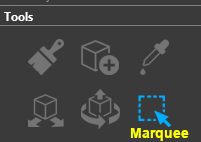 |
|
||||||||
Loading an Existing RouteYou must first find and select the route to load from those already installed. At the top of the Driver/Surveyor screen the route search options are shown as a set of buttons.
This will produce a display of thumbnails at the bottom of the screen.
Click on the thumbnail for the route you want to load, then click on the EDIT ROUTE button to load the route into Surveyor.
Loading a Route Into Surveyor From Content ManagerTrainz provides a shortcut that allows you to load an existing route directly into Surveyor for editing from Content Manager.
Loading After an Unexpected ShutdownIf you select a route for loading after an unexpected shutdown of Trainz then any route (or route and session) that was open and running in Trainz Surveyor or Driver will be left marked as Open for Edit. When you attempt to load this route into Surveyor or Driver you will see a message listing the route and session (if any) that were affected.
The message is saying that the assets in the list may have been changed since the last time you loaded them and exited Trainz normally. For example if you had been editing the route and/or session and had experienced a crash to the desktop or had used Windows Task Manager to terminate the program. The options you will see are:-
You could also use the Content Manager program (select Manage Content from the Trainz Launcher) to Submit the open route or route and session assets. This has the risk of replacing the last good copy of that asset or assets with a possibly faulty copy.
Editing a Route
When you create a new route (with or without a named session), or load an existing route without a session, and start adding scenery assets they will automatically be placed into a Route Layer. See Any ground textures, water, effect layers (turfFX and clutter) you add, or terrain changes (including new baseboards) you make, will be added to the Route Data.
Effect LayersThe Effect Layers tool allows you to add, remove and edit special ground effect layers that contain:-
‡ The TurfFX Effect Layer is hardware dependent and requires an Nvidia graphics card. TurfFX is an Nvidia software product and is not from N3V.
Merging Routes
There are some important restrictions on the merging of two routes:-
What is a Session?
In general, while a route provides the physical structures (or "hardware"), a session provides the services (or "software"). While you can easily have a route without a session, it could be a very limited (or even a boring) experience. A single route can have multiple sessions, or none, but a session must always belong to a route. To put it into Trainz terminology, a session has a route as a dependency. A session consists of two parts:-
Session Data: Session Data are often the "invisibles" that control the operation of a session. Session rules, driver orders and loco assignments, commodities (loaded, unloaded and carried) and most of the Environmental Settings are examples of Session Data.
Session Data contains:-
Session Layers give you a way of organising or grouping the assets displayed in your session.
Loading (and Creating) a SessionCreating a New Session
A new session can be created in two ways:-
Both methods will load the route into Surveyor and create a new session with all its values/parameters set at default levels. Loading an Existing SessionThere are two different ways to load existing sessions into Surveyor.
This will produce a list of session thumbnails at the bottom of the screen. As with the route thumbnails, the list can be scrolled horizontally.
The same colour coding system used in the route thumbnails also applies to session thumbnails.
Loading a Session Into Surveyor From Content ManagerTrainz provides a shortcut that allows you to load an existing session directly into Surveyor for editing from Content Manager.
Loading a Session into Driver From SurveyorTo start Driver simply select a session as described above in Loading an Existing Session and click the DRIVE SESSION button.
This will load both the session and the route into Driver. You can save your "game play" in Driver at anytime. See Loading a Session into Driver From Content ManagerTrainz provides a shortcut that allows you to load an existing session directly into Driver from Content Manager.
Editing a Session
When you create a new session, or load an existing session, and start adding scenery assets in Surveyor they will automatically be placed into a Session Layer. See the Trainz Wiki Page Any changes made to the Session Rules (including drivers and their commands), the Environment Tools, Industry or Rolling Stock settings, will be added to the Session Data. There are also other changes that will be added to the Session Data.
Saving a Route and a SessionRoutes and Sessions are saved from the System Menu on the Surveyor screen.
Saving a New Route and SessionIf you have created a new route and select Save or Save As..., then you will be presented with the following Save Route Dialogue Windows.
Saving an Existing Route
Saving an Existing Route and Session
Saving a Route and Session Using the UDS
The UDS (Unified Driver Surveyor) Interface allows you to quickly switch from Driver to Surveyor and back to Driver again without having to restart the session from the beginning. You can edit a route and session while in Surveyor and then switch back to Driver to continue the session where you left it.
Unless you have a particular reason for overwriting the original Session then the recommended save options are:-
If you have have NOT edited anything while in Surveyor and select Save then you will be shown the Save Driver Session dialogue window to save the session in its current state as a Driver Game (also called a Game or Driver Game). This is exactly the same as pressing Ctrl S while in Driver. Exiting SurveyorIf you exit Surveyor after editing without saving then you will be prompted to Save.
Cloning a Route/Session
Using SurveyorRoutes and Sessions that have been loaded into Surveyor can be cloned using the Save As... command from the Surveyor System Menu
Enter a new name or edit the original name (as shown above) for your cloned route or session.
Using Content Manager 1. Select the Route or Session to Clone
In the image above the original Route has been cloned and given a new <kuid> value.
Saving and Loading Driver Games in DriverSaving Driver Games
Loading Driver GamesSaved driver games will be shown with their sessions for a selected route. The section Using Method 2: select the route first and then click the VIEW SESSIONS button. This will display a list of thumbnails for all the sessions and driver games in that route.
Where there is only one session in a route, the session will be the first thumbnail shown in the list followed by the driver games. Note that the session is selected by default. Select (hightlight) the Driver Game you want to load and click the DRIVE SESSION button.
This will load the Driver Game, the session and the route into Driver.
Editing Driver GamesIt is possible to load and edit a saved Driver Game in versions of Trainz that have the UDS (Unified Driver Surveyor) interface - these versions are TRS19 Platinum, Trainz Plus and TRS22. However, when you save your edit, it will NOT be saved as an update to the loaded Driver Game. Instead it will be saved as a Session. You can select to create a new session or to overwrite the original session. The Session will be saved with all the:-
Deleting Routes and Sessions
The Type column will identify each entry as a route, session or Misc. Misc in this case means a saved Driver Game. You can delete routes and/or sessions individually but if you delete a route by itself then its dependant sessions and driver games will be shown as faulty with Missing dependencies. Likewise, if you delete a session by itself then its dependant driver games will be shown as faulty with Missing dependencies. Trainz Wiki
This page was created by Trainz user pware in September 2021 and was last updated as shown below. |
||||||||||||||||||||||||||||||||||||||||||||||||||||||||||||||||||||||||||||||||||||||||||||||||||||||||||||||||||||||||||||||||||||||||||||||||||||||||||||||||||||||||||||||||||||||||||||||||||||||||||||||||||||||||||||||||||||||||||||||||||||||||||||||||||||||||||||||||||||||||||||||||||||||||||||||||||||||||||||||||||||||||||||||||||||||||||||||||||||||||||||||||||||||||||||||||||||||||||||||||||||||||||||||||||||||||||||||||||||||||||||||||||||||
